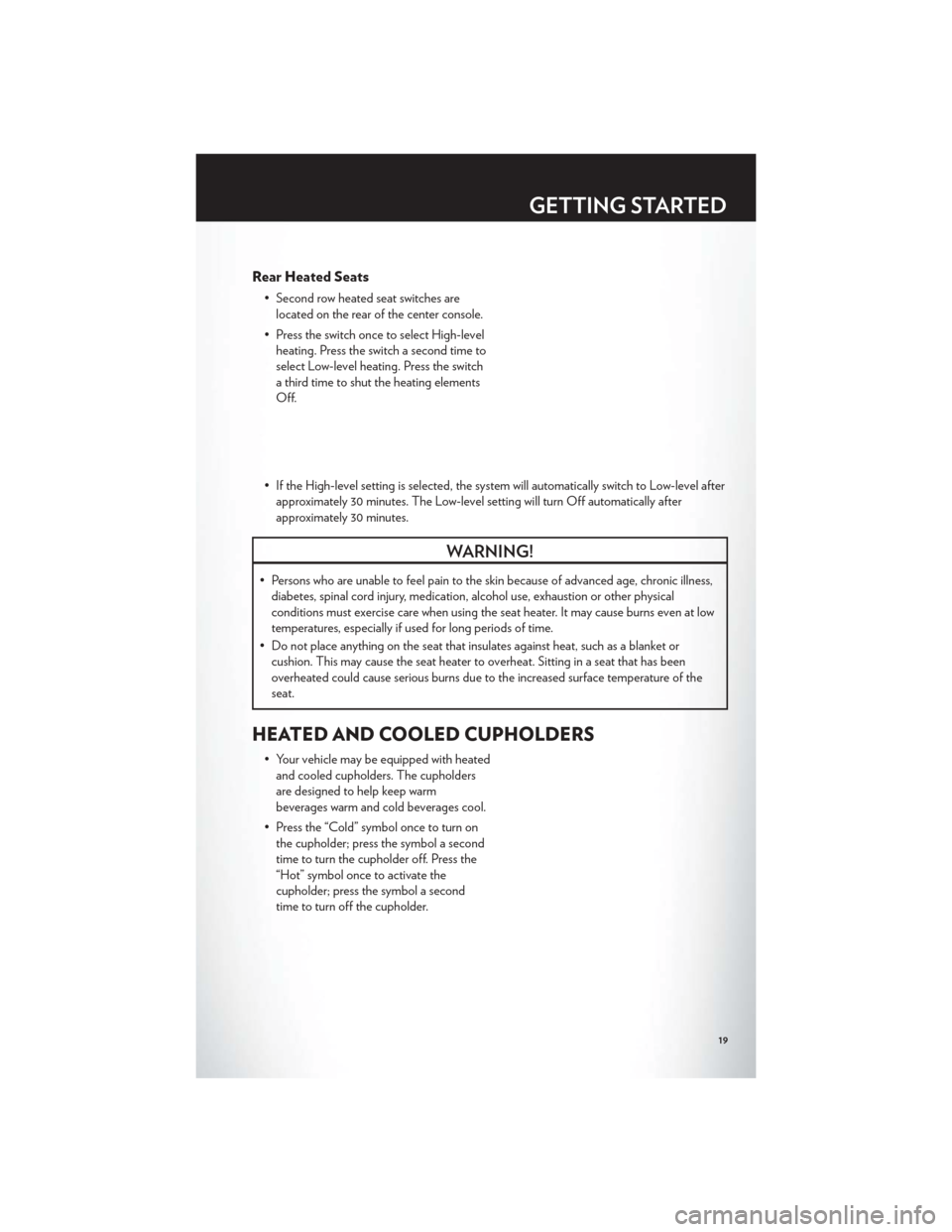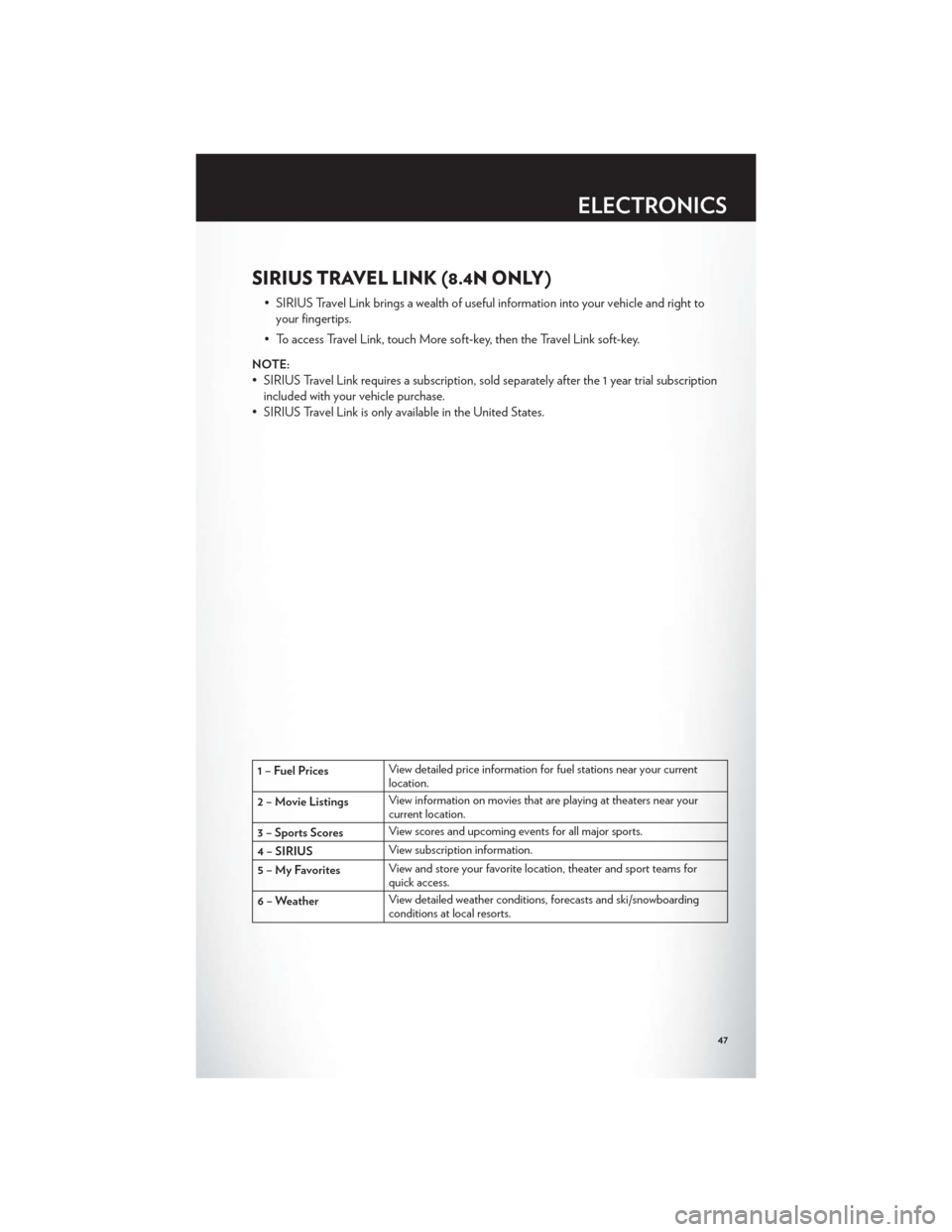heater CHRYSLER 300 2012 2.G User Guide
[x] Cancel search | Manufacturer: CHRYSLER, Model Year: 2012, Model line: 300, Model: CHRYSLER 300 2012 2.GPages: 124, PDF Size: 3.67 MB
Page 21 of 124

Rear Heated Seats
• Second row heated seat switches arelocated on the rear of the center console.
• Press the switch once to select High-level heating. Press the switch a second time to
select Low-level heating. Press the switch
a third time to shut the heating elements
Off.
• If the High-level setting is selected, the system will automatically switch to Low-level after approximately 30 minutes. The Low-level setting will turn Off automatically after
approximately 30 minutes.
WARNING!
• Persons who are unable to feel pain to the skin because of advanced age, chronic illness,diabetes, spinal cord injury, medication, alcohol use, exhaustion or other physical
conditions must exercise care when using the seat heater. It may cause burns even at low
temperatures, especially if used for long periods of time.
• Do not place anything on the seat that insulates against heat, such as a blanket or cushion. This may cause the seat heater to overheat. Sitting in a seat that has been
overheated could cause serious burns due to the increased surface temperature of the
seat.
HEATED AND COOLED CUPHOLDERS
• Your vehicle may be equipped with heatedand cooled cupholders. The cupholders
are designed to help keep warm
beverages warm and cold beverages cool.
• Press the “Cold” symbol once to turn on the cupholder; press the symbol a second
time to turn the cupholder off. Press the
“Hot” symbol once to activate the
cupholder; press the symbol a second
time to turn off the cupholder.
GETTING STARTED
19
Page 49 of 124

SIRIUS TRAVEL LINK (8.4N ONLY)
• SIRIUS Travel Link brings a wealth of useful information into your vehicle and right toyour fingertips.
• To access Travel Link, touch More soft-key, then the Travel Link soft-key.
NOTE:
• SIRIUS Travel Link requires a subscription, sold separately after the 1 year trial subscription included with your vehicle purchase.
• SIRIUS Travel Link is only available in the United States.
1 – Fuel Prices View detailed price information for fuel stations near your current
location.
2 – Movie Listings View information on movies that are playing at theaters near your
current location.
3 – Sports Scores View scores and upcoming events for all major sports.
4 – SIRIUS View subscription information.
5 – My Favorites View and store your favorite location, theater and sport teams for
quick access.
6 – Weather View detailed weather conditions, forecasts and ski/snowboarding
conditions at local resorts.
ELECTRONICS
47
Page 74 of 124

IF YOUR ENGINE OVERHEATS
• In any of the following situations, you can reduce the potential for overheating by takingthe appropriate action.
• On the highways — slow down.
• In city traffic — while stopped, place the transmission in NEUTRAL, but do not increase engine idle speed.
NOTE:There are steps that you can take to slow down an impending overheat condition:
• If your air conditioner (A/C) is on, turn it off. The A/C system adds heat to the engine cooling system and turning the A/C off can help remove this heat.
• You can also turn the temperature control to maximum heat, the mode control to floor and the blower control to high. This allows the heater core to act as a supplement to the radiator
and aids in removing heat from the engine cooling system.
CAUTION!
Driving with a hot cooling system could damage your vehicle. If the temperature gauge
reads 240°F (116 °C) or greater pull over and stop the vehicle. Idle the vehicle with the air
conditioner turned off until the pointer drops back into the normal range 200–230°F
(93–110°C). If the pointer remains at 240°F (116°C) or greater and you hear a chime, turn
the engine off immediately and call for service.
WARNING!
You or others can be badly burned by hot engine coolant (antifreeze) or steam from your
radiator. If you see or hear steam coming from under the hood, do not open the hood until
the radiator has had time to cool. Never try to open a cooling system pressure cap when
the radiator or coolant bottle is hot.
WHAT TO DO IN EMERGENCIES
72
Page 86 of 124

NOTE:The remote battery posts are viewed by standing on the right side of the vehicle
looking over the fender.
• Set the parking brake, shift the automatic transmission into PARK and turn the ignition toOFF.
• Turn off the heater, radio, and all unnecessary electrical accessories.
• If using another vehicle to jump-start the battery, park the vehicle within the jumper cables reach, set the parking brake and make sure the ignition is OFF.
Jump-Starting Procedure
• Connect the positive (+)end of the jumper cable to the remote positive (+)post of the
discharged vehicle.
• Connect the opposite end of the positive (+)jumper cable to the positive(+)post of the
booster battery.
• Connect the negative end (-)of the jumper cable to the negative (-)post of the booster
battery.
• Connect the opposite end of the negative (-)jumper cable to the remote negative(-)post
of the vehicle with the discharged battery.
• Start the engine in the vehicle that has the booster battery, let the engine idle a few minutes, and then start the engine in the vehicle with the discharged battery.
Once the engine is started, remove the jumper cables in the reverse sequence:
• Disconnect the negative (-)
jumper cable from the remote negative (-)post of the vehicle
with the discharged battery.
• Disconnect the negative end (-)of the jumper cable from the negative (-)post of the
booster battery.
• Disconnect the opposite end of the positive (+)jumper cable from the positive(+)post of
the booster battery.
• Disconnect the positive (+)end of the jumper cable from the remote positive (+)post of the
discharged vehicle.
• If frequent jump-starting is required to start your vehicle you should have the battery and charging system inspected at your authorized dealer.
CAUTION!
• Do not use a portable battery booster pack or any other booster source with a systemvoltage greater than 12 Volts or damage to the battery, starter motor, alternator or
electrical system may occur.
• Failure to follow these procedures could result in damage to the charging system of the booster vehicle or the discharged vehicle.
• Accessories that can be plugged into the vehicle power outlets draw power from the vehicle’s battery, even when not in use (i.e., cellular phones, etc.). Eventually, if plugged in
long enough, the vehicle’s battery will discharge sufficiently to degrade battery life
and/or prevent the engine from starting.
WHAT TO DO IN EMERGENCIES
84
Page 98 of 124

FLUIDS AND CAPACITIESNon SRT8ComponentFluid, Lubricant, or Genuine Part Capacities
Engine Coolant 3.6 Liter Engine without All
Wheel Drive MOPAR® Antifreeze/Coolant 5
Year/100,000 Mile Formula HOAT (Hybrid
Organic Additive Technology) or equivalent.11.1 Quarts (10.5 Liters) Includes heater and
coolant recovery bottle filled to MAX level.
Engine Coolant 3.6 Liter Engine with All Wheel
Drive MOPAR® Antifreeze/Coolant 5
Year/100,000 Mile Formula HOAT (Hybrid
Organic Additive Technology) or equivalent.11.4 Quarts (10.8 Liters) Includes heater and
coolant recovery bottle filled to MAX level.
5.7 Liter Engine without Severe Duty II Cooling
System MOPAR® Antifreeze/Coolant Five
Year/100,000 Mile FormulaHOAT (Hybrid
Organic Additive Technology) or equivalent.14.7 Quarts (13.9 Liters) Includes heater and
coolant recovery bottle filled to MAX level.
5.7 Liter Engine with Severe Duty II Cooling
System MOPAR® Antifreeze/Coolant Five
Year/100,000 Mile FormulaHOAT (Hybrid
Organic Additive Technology) or equivalent.15.1 Quarts (14.3 Liters) Includes heater and
coolant recovery bottle filled to MAX level.
Engine Oil with Filter 3.6L API Certified SAE 5W-30 engine oil, meeting
Chrysler Material Standard MS-6395. Refer to
your engine oil filler cap for correct SAE grade. 6 Quarts (5.6 Liters)
Engine Oil with Filter 5.7L API Certified SAE 5W-20 engine oil, meeting the
requirements of Chrysler Material Standard
MS-6395. Refer to the engine oil filler cap for
correct SAE grade. 7 Quarts (6.6 Liters)
Engine Oil Filter 3.6L, 5.7L MOPAR® Engine Oil Filter or equivalent. —
Spark Plug 3.6L RER8ZWYCB4 (Gap 0.043 in [1.1 mm]) —
Spark Plug 5.7L LZFR5C–11 (Gap 0.043 in [1.1 mm]) —
Automatic Transmission – 3.6L Engine Shell L12108 Transmission Fluid or equivalent. —
Automatic Transmission – 5.7L Engine MOPAR® ATF+4® Automatic Transmission Fluid
or equivalent licensed ATF+4® product. —
MAINTAINING YOUR VEHICLE
96
Page 100 of 124

SRT8ComponentFluid, Lubricant, or Genuine Part Capacities
Engine Coolant 6.4L MOPAR® Antifreeze/Coolant Five
Year/100,000 Mile FormulaHOAT (Hybrid
Organic Additive Technology) or equivalent. 15.2 Quarts (14.4 Liters) Includes heater and
coolant recovery bottle filled to MAX level.
Engine Oil With Filter 6.4L For best performance and maximum protection
under all types of operating conditions, the
manufacturer only recommends full synthetic
engine oils that meet the American Petroleum
Institute (API) categories of SM or SM/CF. The
manufacturer recommends the use of a full
synthetic SAE 0W-40 engine oil or equivalent. 7 Quarts (6.6 Liters)
Engine Oil Filter 6.4L MOPAR® Engine Oil Filter or equivalent. —
Spark Plugs 6.4L LZTR6AP11EG (Gap 0.043 in [1.1 mm]) —
Automatic Transmission – 6.4L Engine MOPAR® ATF+4® Automatic Transmission Fluid
or equivalent licensed ATF+4® product. —
Axle Rear (SRT8) MOPAR® Synthetic Gear Lubricant SAE 75W–90
(API GL-5) or equivalent (with MOPAR® Friction
Modifier – Hypoid Gear Additive). —
Power Steering Reservoir (SRT8) MOPAR® Power Steering Fluid + 4, MOPAR®
ATF+4® Automatic Transmission Fluid or
equivalent licensed ATF+4® product. —
Fuel Selection 6.4L Premium Unleaded 91 Octane Only or higher. 19.1 Gallons (72 Liters) (Approximate)
MAINTAINING YOUR VEHICLE
98